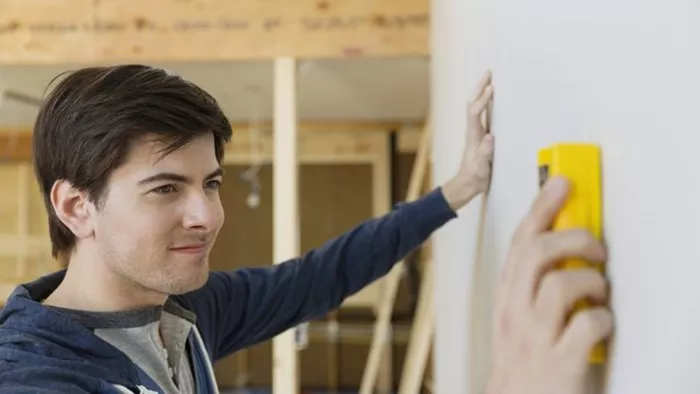Finding a stud in your wall without a stud finder is possible using several methods. Here’s a detailed guide to help you locate studs using simple tools and techniques.
1. Knock Test
Tap on the Wall: Gently tap on the wall with your knuckles or a small hammer. Listen for changes in sound.
Hollow vs. Solid: Areas without a stud will sound hollow, while areas with a stud will sound more solid and less resonant. The sound difference can be subtle, so take your time to listen carefully. This method works best in quieter environments where you can concentrate on the sound variations.
Tip: Practice on a wall where you know the stud locations to familiarize yourself with the sound difference. This will help you develop a better ear for identifying the presence of studs in different types of walls, such as drywall or plaster.
2. Use a Magnet
Obtain a Strong Magnet: A refrigerator magnet might work, but a stronger magnet, such as a neodymium magnet, is more effective. Neodymium magnets are powerful enough to detect even the smallest metal components within the wall.
Move the Magnet Slowly: Slide the magnet across the wall. When it sticks, you’ve likely found a nail or screw head embedded in a stud. Pay attention to the areas where the magnet clings, and mark those spots for further investigation.
Tip: Use a piece of string to create a magnet pendulum. This allows you to move the magnet smoothly across the wall surface. The pendulum method can help you cover larger areas more quickly and accurately, ensuring you don’t miss any potential stud locations.
3. Look for Clues
Inspect Baseboards and Trim: Look for small holes or indentations where nails may have been used to attach trim to the studs. These subtle marks often indicate the precise location of the studs behind the wall.
Observe Outlets and Switches: Electrical outlets and light switches are often mounted on the side of a stud. Remove the cover plate and check which side the outlet or switch box is attached to. This can give you a good starting point for locating other studs.
Tip: Measure from the outlet or switch to the next stud location (usually 16 or 24 inches apart). By understanding the standard spacing between studs, you can predict where other studs are likely to be found, making the search process more efficient.
See also: How To Use A Stud Finder?
4. Measure from a Corner
Standard Stud Spacing: Most studs are spaced 16 or 24 inches apart from each other. This standardized spacing can help you predict stud locations with reasonable accuracy.
Start from a Corner: Measure out from a corner of the room and mark every 16 or 24 inches to locate probable stud positions. Be consistent in your measurements to ensure you are accurately following the stud pattern.
Tip: Verify by using the knock test or magnet method to confirm the presence of a stud. Combining multiple methods increases the likelihood of accurately locating the studs, reducing the risk of errors.
5. Use a Flashlight
Shine a Flashlight Parallel to the Wall: Angle the flashlight to cast shadows across the wall. This technique can highlight any subtle variations on the wall’s surface.
Look for Dimples: The light will highlight slight indentations or dimples in the wall where nails or screws are fastened into studs. These dimples may be faint, so look closely and carefully along the wall.
Tip: This method works best in darker rooms or during the evening. The lower ambient light helps the flashlight’s beam create more pronounced shadows, making it easier to spot the dimples indicating stud locations.
6. Check for Stud Patterns
Standard Patterns: Builders often follow a standard pattern when placing studs. Once you find one stud, the others are likely to follow the same spacing. Understanding these patterns can make the search process more systematic.
Repeat Measurements: Measure from a known stud location to find others. Consistently applying this method helps to map out the stud layout accurately.
Tip: Confirm each stud with the knock test or magnet method to ensure accuracy. Double-checking your findings with different techniques helps avoid mistakes and ensures that you have accurately identified the stud locations.
See also: How Far Apart Should Studs Be For Optimal Support?
7. Use a Wire Hanger
Straighten a Wire Hanger: Bend a wire hanger into a right-angle shape. This makeshift tool can be very effective for probing the wall.
Insert into the Wall: Poke the hanger into the wall through a small hole and feel for resistance, indicating a stud. Carefully maneuver the hanger to get a clear sense of the stud’s location and dimensions.
Tip: Be cautious not to damage electrical wiring or plumbing hidden in the walls. Always proceed gently and with awareness of potential hazards behind the wall surface to avoid causing any unintended damage.
8. Explore with a Drill
Drill Small Holes: Drill tiny holes (about 1/16 inch) into the wall where you expect a stud to be. These small exploratory holes can provide definitive confirmation of a stud’s presence.
Feel for Resistance: If you hit a stud, you will feel more resistance and see wood shavings on the drill bit. This direct feedback is a reliable indicator of a stud’s location.
Tip: Patch these small holes with spackle afterward to maintain the wall’s appearance. Properly sealing and smoothing out the holes ensures that your wall remains aesthetically pleasing and intact.
Conclusion
Finding a stud without a stud finder involves a combination of listening, observing, measuring, and sometimes a bit of trial and error. By using these methods, you can accurately locate studs to safely hang heavy items on your walls. Always double-check your findings with multiple methods to ensure you have correctly identified the stud locations. Each method has its strengths, and by combining them, you can increase your confidence and accuracy in locating studs behind your walls.
Related Topics:

